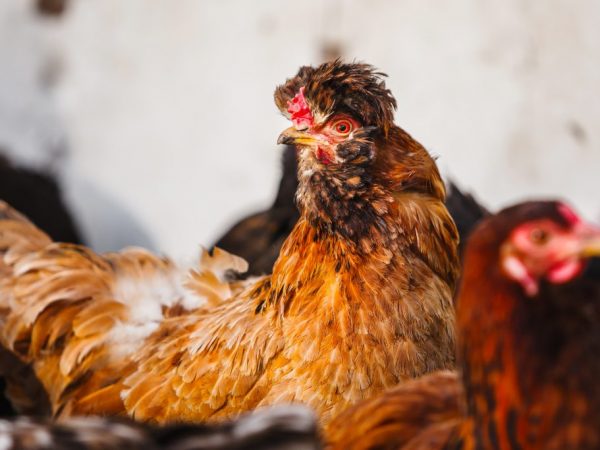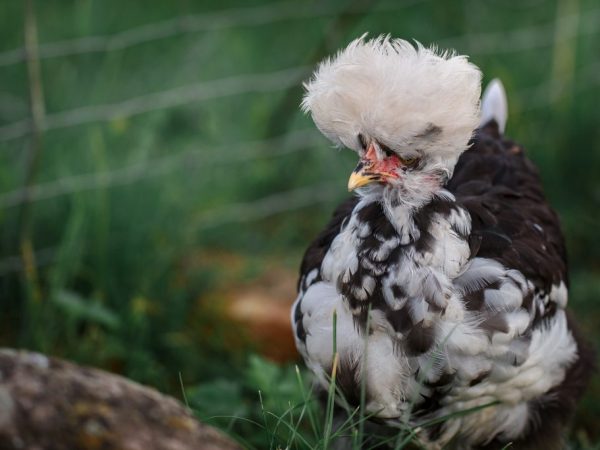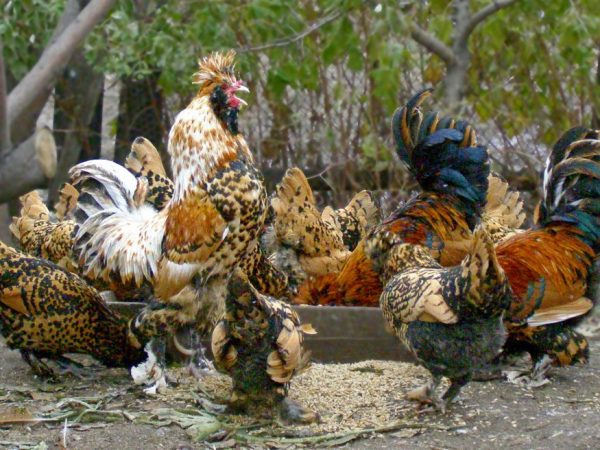Breeding Pavlovsk chickens
Pavlovsk chickens appeared in the domestic poultry industry in the 18th century, over time they practically disappeared, but in recent years the breed line has been reviving and becoming more and more popular. The modern exterior of the birds was obtained by crossing the Sultan, faverol and la-fresh, as well as Dutch breeds. The bird was named after the village of Pavlovo.

Breeding Pavlovsk chickens
Subspecies
The breed line of Pavlovsk chickens is divided into two main subspecies.
Silvery
The main colors of the silver pavlovka are white, diluted with silver or gray-black blotches. Intense shine is observed only in dark areas where there is a green tint.
Golden
Chickens and roosters, golden with a brown tint, are distinguished by bright plumage. The brown color of the feathers at the ends smoothly turns into black, folding into a V-shaped "edging", which begins on the crest and through the neck, the shoulder region and back passes to the lumbar region.
On the outside, the protective cover is spotty. The first-order feather is brown-gold on the inside, much darker on the outside.
Characteristic
Pavlovsk chickens are meat-and-meat breeds. They are bred on farms and in personal subsidiary plots.
The cost
For the price, chickens from the village of Pavlovo, unlike other decorative breeds, are not among the expensive ones. The average cost of a chicken is up to 300-400 rubles. per individual. The price of an adult bird starts from 600-1000 rubles.
Appearance
In appearance, the Pavlovsk chicken looks like a pheasant:
- horizontally located body, compactly folded;
- medium-sized dorsal region;
- the fluffy tail is raised up, it is thick and fan-shaped;
- bluish-black paws, feathered on both sides, with a hawk-like poplite (a tuft on the lower leg), with feathers bent in the form of spurs, and 4 feathered toes on the paws;
- well-developed humeral region, on the wings the flight feather fits snugly to the body, in some cases protrudes beyond the contour;
- small size and rounded head with a helmet-shaped crest;
- small undeveloped lobes and crest, the crestal base is located near the parietal region, in the transverse direction in relation to the head;
- beak straight or slightly curved, with a noticeable septum and raised nostrils, thin, pink, yellow or black-blue;
- bulging eyes of medium size, yellow or black;
- the periocular region and cheeks are covered with protruding feathers that form a beard and tubs;
- tight neck collar.
The color of the plumage depends on belonging to the breed variety and can be in silver or golden tones, including black and white, fawn, white, black and gold. The general characteristic of the feather cover, by which it is easy to identify the Pavlovka, is spotting and variegation.
According to the external description, roosters differ little from chickens and, as signs of gender, have:
- a more lush collar area;
- more powerful thoracic region, protruding forward;
- large, upright tail, formed by long and curved braids;
- long and well developed spurs on the feet.
Disqualifying features in the description include:
- increased density of plumage on the paws or its complete absence;
- uncharacteristic color for the breed;
- the presence of the fifth finger on the limbs;
- excessively spreading crest;
- color of paws not corresponding to Pavlovka.
Character

Birds must be kept behind a fence
By its nature, the breed is active and mobile, prone to fussiness. Birds are able to fly over obstacles and therefore require the organization of fences during containment, but they do not go long distances, being tied to their place of residence.
The Pavlovsky rooster, according to the observations of the owners, is distinguished by a cocky character, however, it can adapt in a short period of time to living together with other poultry, for example, ducks, geese and turkeys. To avoid conflicts, poultry farmers will build a separate cock pen.
In relation to the owner, they are friendly, they do not show aggression.
Incubation instinct
According to the description, the Pavlovsk breed has well-developed instincts for incubating and feeding chicks, thanks to which, on average, 90% of chicks survive. Layers are able to incubate not only their own offspring, but also those of others.
You can put up to 10 eggs under one hen.
In the process of breeding, blende is placed in the nests for chickens - a white stone, which makes it possible to exclude egg-laying outside the nesting sites.
Productivity
The breed has average performance indicators:
- the weight of a young rooster is from 1.6 to 1.9 kg, an adult bird gains a mass of no more than 3 kg, in which it is significantly inferior to broilers;
- laying hen weight - about 2 kg;
- egg production - no more than 200 eggs per year, eggs weighing 50-60 g, shell color beige or white.
Advantages and disadvantages of the breed
In Pavlovsk chickens, poultry farmers note a number of advantages:
- low feed intake;
- early maturity;
- good taste of meat and eggs;
- high percentage of chick survival.
Among the disadvantages are the low probability of acquiring a purebred representative and low egg production. Also, not all poultry farmers like their fussiness.
Breeding features
Laying hens begin to lay at the age of 6-7 months. They continue to rush up to 4-5 years. For regular egg production, the duration of daylight hours should be at least 14 hours, but not more than 16 hours.
Incubation period
Eggs weighing about 60 g are taken for incubation. Chicks are hatched using a brooding hen or in an incubator. The incubation period takes up to 3 weeks.
Chicks feeding
In the first week of life, chickens are fed with cottage cheese and a mixture of hard-boiled eggs, wheat, corn or boiled millet. Fresh grass (alfalfa, clover, nettle), as well as vegetables (potatoes and carrots) are introduced into their diet from the 3rd day.
By the end of the first week after birth, the menu of young animals includes wet and dry mash, tops, grass flour and yeast.
Chick care
Pavlovsky chickens are characterized by intensive growth and are quickly covered with plumage.
Incubator chicks are kept separately from the family, ensuring the required temperature for them with the help of heating devices (reflectors and electric lamps with a power of 100-150 W):
- from 1 to 5 days - about 30 ° С;
- from 6 to 10 days - about 26 ° С;
- from the 10th - about 18 ° С.

The breed is fast growing
The discomfort caused by an incorrectly selected temperature regime will be indicated by the behavior of the chicks:
- with hypothermia, they begin to fuss and clump together, lose their appetite;
- when the air temperature is too high, the chicks open their beaks, try to drink a lot and move with their wings spread.
Artificial heating is stopped as soon as the chickens are completely covered with plumage (45-50 days).
Maintenance of adults
Chickens and roosters of the Pavlovsk breed, unpretentious to the conditions of keeping, are able to tolerate frosts due to their dense plumage and high physical activity.
Chicken coop requirements
Unheated but draft-proof chicken coops are suitable for keeping poultry. The optimal size for a herd of 15 units is an area of 3 m² and a ceiling height of up to 2 m. A prerequisite is the presence of natural ventilation (window opening).
In the hen house for a free exit, a manhole is organized, the doors of which are insulated for the winter. The perches are mounted at a height of about 0.8 m from the floor. Nests (0.35 x 0.35 x 0.3 m) are placed throughout the room and lined with hay or straw.
The floor in the hen house for the winter is insulated with a layer of straw or sawdust. The litter is changed once a year, and the hay in the nests is changed once a month. Feeders and drinkers are cleaned every 2 months or as they become dirty.
Food
Low consumption of feed and undemanding composition of the diet simplifies the care of Pavlovka. With free summer range, they find food on the street on their own, eating green grass, worms and insects.
The winter diet consists of cereals, wet mash, compound feed, bran and vitamin admixtures. The consumption rate of compound feed per animal in winter is about 50 g.
Vitamin mixtures are prepared from carrots, potatoes and seasonal fruits.
Proportions for the distribution of feed in winter: 1/3 - solid, 2/3 - wet mash. Be sure to include in the menu mineral supplements and plant products - beans, meal, cake, nettle and yeast.
Laying hens are additionally introduced into the diet with feed mixtures with an increased proportion of protein - meat and fish meal, dairy products.
It is recommended to adhere to the following diet:
- food intake - 3-4 times a day;
- the sequence of dispensing feed - in the morning - 1/3 of grain, after 2 hours - wet feed, in the evening - grain residues.
Walking requirements
Due to the high physical activity inherent in the breed, Pavlovka poorly tolerate cells and need to organize a place for regular walking.
In the summer season, the time spent by birds in the hen house is reduced, leaving them free-range throughout the day.
On the street for chickens, they put a container filled with a mixture of ash and river sand, in which they clean the feathers.
Diseases
The breed has a strong immune system. If provided with adequate food, birds rarely get sick. Standard preventive measures include vaccinations against major diseases - Marek, Newcastle and Gumboro.
If the required amount of vitamin supplements is exceeded, the chickens begin to suffer from liver dysfunction, and with a lack of calcium, they often lay eggs without shells.
Owner reviews
According to the owners, the Pavlovsk Crested breed is easy to care for and does not differ from other types of poultry in terms of economic characteristics.
Many private farmers grow golden and silver Pavlovka not for meat and eggs, because her productivity is average, and because of her bright plumage.


